![]() 1st Battalion 22nd Infantry
1st Battalion 22nd Infantry ![]()
Ist Lieutenant Walter L. Taylor
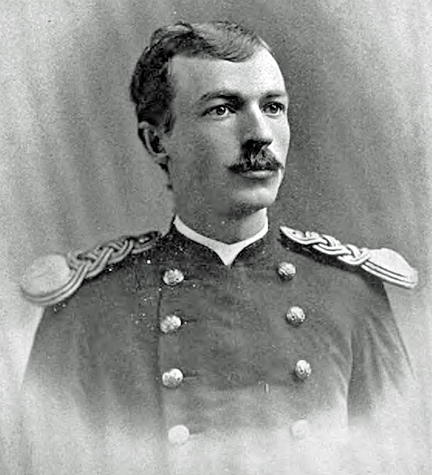
1st Lieutenant Walter Lucian Taylor
During the Spanish-American War
the United States Army lost 385 Soldiers killed in action and
2061 dead from disease. 1
Those dead from disease included casualties lost to malaria,
yellow fever, typhoid fever, dysentery and several other
tropical ailments of non-specific nature. The huge amount of men
sick from all kinds of causes was so great that,
out of fear of contagion the Army sent to Cuba and Puerto Rico
was quarantined upon their return at a specially set-up
quarantine camp at Montauk, New York. The camp was named Camp
Wikoff in honor of Colonel Charles A. Wikoff
of the 22nd Infantry, who was detached from the Regiment and
given command of a Brigade just before the troops
landed in Cuba. Wikoff was killed in action while leading his new
command into the fight at San Juan Hill.
One of the Regulars of the 22nd
Infantry who succumbed to disease and died
was 1st Lieutenant Walter L. Taylor of Company D 2nd Battalion
22nd Infantry. 2
Walter Lucian Taylor was born in
Georgia on May 26, 1865. At one month beyond the age of eighteen
he entered the
US Military Academy on July 1, 1883. His grades at the Academy
were quite low, his best subjects being Tactics,
Spanish and Mathematics, his worst subjects were Law, Engineering
and Drawing. Interestingly, one of his instructors
in Mathematics was 2nd Lieutenant Harry C. Hodges, on temporary
duty at the Academy from the 22nd Infantry.
The two would later serve together when Taylor was assigned to
the 22nd Infantry.
Taylor graduated 60 out of a
class of 64 and was commissioned a 2nd Lieutenant on June 11,
1887. From June 12
to August 31, 1887 he was on temporary duty with the 16th
Infantry as an "additional" 2nd Lieutenant. When a
position
became open in the 20th Infantry he was assigned to that unit on
August 31, 1887. He joined Company F at Fort Assiniboine,
Montana Territory on September 25, 1887.
He was with Company F at Log
Camp, Montana Territory from August 22 to September 5, 1888 and
then back to Fort
Assiniboine where he commanded Company F from December 17, 1888
to January 12, 1889. From June 6-16, 1889 he was
sick in quarters from "acute muscular rheumatism of right
hip in line of duty." In August 1889 he was at Camp Lodge
Pole Creek,
Montana.
Taylor was Battalion Adjutant of 3rd Battalion 20th Infantry from August 26 - September 14, 1889.
In October 1889 he was with his
Company at Camp Poplar River, Montana where he was acting signal
officer & in charge
of post schools until March 1890. From March 3 to May 2, 1890 he
was on leave. In June 1890 he was appointed acting signal officer
& in charge of post schools & post adjutant at Camp
Poplar River. From August 1-17 he was at Fort Snelling, Minnesota
on detached service in connection with the Department rifle
contest.
Taylor commanded Company F at
Fort Assiniboine from March 20 - April 21, 1891. He went with his
Company to Fort Buford,
North Dakota in May 1891 where he became the topographical
officer, signal officer and engineering officer. He again
commanded
Company F from May 25 - June 5, 1891.
He was sick in his quarters at
Buford from July 20 to August 7, 1891. On August 25 he was on
leave with a surgeon's certificate
of disability with authorization to go to the General Hospital at
Hot Springs, Arkansas should the need arise. He remained out on
leave until March 1892 when he rejoined Company F at Fort
Assiniboine. He commanded the Company and the post at Assiniboine
from April 3 - 7, 1892. He was sick in quarters from June 15 to
July 10.
From August 6 - 19, 1892 Taylor
was at Fort Keogh, Montana as a competitor in the Department
rifle contest. He was out sick
from August 18 to October 22, 1892. From June 11 to July 17, 1893
he was on Special Duty commanding Company D 20th Infantry.
Taylor commanded Company F at Fort Assiniboine from September 6
to November 7 and again from December 11 - 21, 1893.
On February 24, 1894 he was
detailed to the University of Alabama where he became Professor
of Military Science & Tactics.
In May 1894 he was officially transferred to Company H 20th
Infantry. He was relieved of his detail to the University in
August 1894
and went on duty with the Alabama State Troops until into
September 1894. He rejoined his Company on duty at Fort
Leavenworth,
Kansas on October 13, 1894.
Taylor was promoted to 1st Lieutenant of the 22nd Infantry on December 29, 1894, and assigned to Company D 22nd Infantry.

Above: The entry for
Walter L. Taylor in the Returns of the 20th Infantry for the
month of December 1894 noting that he was a loss
to Company H 20th Infantry by his promotion to 1st Lieutenant of
the 22nd Infantry.
Taylor joined Company D of the
22nd Infantry at Fort Assiniboine, Montana on February 7, 1895
and immediately
assumed command of the Company from 2nd Lieutenant William H.
Wassell as Captain Benjamin C. Lockwood
was absent on leave and Taylor thus became the ranking officer in
the Company.
He continued to command Company
D at Fort Assiniboine while Lockwood was on recruiting duty until
September 1895
when he moved with the Company to Fort Yates, North Dakota. He
was on leave from June 24 to August 18, 1896 and while
he was on leave the entire Regiment moved to Fort Crook,
Nebraska.
Taylor commanded Company D at
Fort Crook from August 18, 1896 until June 30, 1897 when Captain
Lockwood
was relieved from recruiting duty and returned to command the
Company.
Taylor took leave from December
6, 1897 to April 21, 1898 when he rejoined his Company at Tampa,
Florida and
then deployed with the Company to Cuba.
At the battle of El Caney, Cuba,
on July 1, 1898, Taylor and his Company were part of the force
from 2nd Battalion
that had chopped its way through jungle while under heavy fire to
get to its assigned objective, covering the Cuabietas
Road. This road was the likely avenue of retreat the Spaniards in
the town of El Caney would take should they be forced
out of their positions in the town. As the attacking force drove
the Spanish defenders into the trap 2nd Battalion
poured a withering fire into them, inflicting severe casualties
within their ranks and causing the enemy to surrender.
Taylor and his fellow officer
from Company D, 2nd Lieutenant William Hudspeth Wassell performed
gallantly in the fight,
Taylor directing the Company since their Company Commander,
Captain Benjamin Lockwood had been appointed as
Battalion Commander for the action. Taylor's valor and that of
Wassell was noticed by Captain Robert N. Getty,
Commander of Company F who took command of 2nd Battalion shortly
after the battle when Lockwood became ill.
In a letter to the Brigade Commander Getty praised the two young
officers who had been classmates of each other
at West Point:
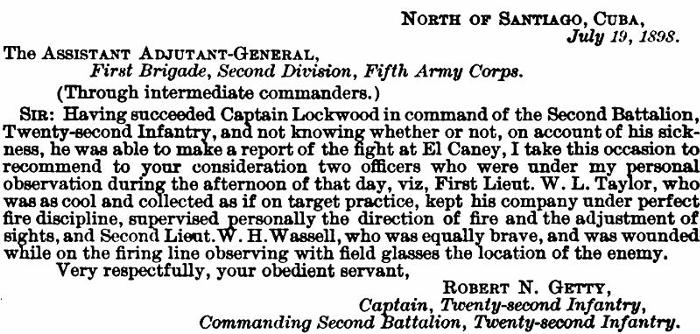 3
3
Walter L. Taylor contracted
malaria during the campaign in Cuba, and then typhoid fever at
Camp Montauk.
He left Camp Wikoff on August 24, 1898 on sick leave with a
surgeon' s certificate attesting to his illness.
He died in New York City on September 18, 1898, was taken home to Thomasville, Georgia, and buried in Laurel Hill Cemetery.

Above: The entry for
Walter L. Taylor in the Returns of the 22nd Infantry for the
month of October 1898
indicating that he died of disease.
On January 30, 1899 President
William McKinley recommended 1st Lieutenant Walter Taylor
for a Brevet promotion to Captain for "gallantry in
battle, El Caney, Cuba, July 1, 1898."
No record could be found to indicate that the Senate ever acted
on the recommendation.
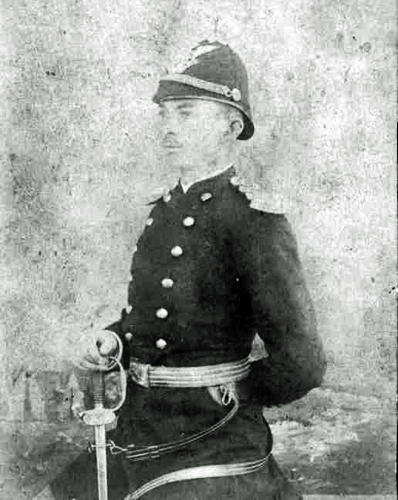
Walter Lucian Taylor in
the dress uniform of an Infantry company grade officer with Model
1860 Foot Officers sword.
Photo identified as taken at Fort Assiniboine, Montana. That
would date it as being taken
between September 1887 and September 1895.
Photo by Kirby_Toni from Ancestry.com
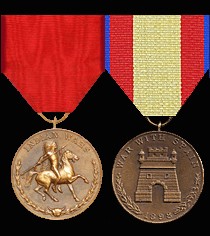
1st Lieutenant Walter L. Taylor's decorations
1st Lieutenant Walter
L.Taylor was remembered by the West Point
Association of Graduates with the following obituary:
WALTER LUCIAN TAYLOR.
No. 3233. CLASS OF 1887. Died, September 18, 1898, at New York City, aged 33.
TAYLOR was born in Thomasville,
Ga., where his family still lives, and his life was spent in that
town until he went
to West Point, at the age of seventeen. After his graduation he
was appointed to the Twentieth Infantry and served with it
in the northwest most of the time, until the breaking out of the
Spanish-American war.
He was for a time Professor of
Military Science and Tactics at the University of Alabama,
Tuscaloosa, Ala., and in the fall of 1894
was on duty with Alabama State troops. He was made First
Lieutenant in the Twenty-second Infantry, December 22, 1894,
and served with it at Fort Leavenworth, Fort Assinniboine, Fort
Yates and Fort Crook. He went through the Santiago campaign
with the Twenty-second Infantry, and although he escaped injury
in the fight, where he constantly exposed himself,
he contracted malarial fever before the troops were brought back
to the United States. Being the only officer on duty with
his company he insisted on remaining with his men, and at Montauk
was taken with typhoid fever. He was taken to a hospital
in New York City, but he had been too much weakened by exposure
on the battle field to withstand the disease.
Lieutenant Taylor married Miss Adele Pitmann, who survives him, and who, with their three children, lives in Thomasville now.
The writer has heard Major R. N.
Getty, First Infantry (then Captain Twenty-second Infantry,)
speak in terms of
unqualified praise of Taylor's cool bravery and his great
efficiency in the fight at El Caney. He said that Taylor,
though exposed constantly to the galling fire, which was causing
many casualties in his company, was not in the least
moved or disturbed by it, but that he constantly went from man to
man, counseling them, examining and arranging their
rifle sights for them, and seeing in every way that the fire of
his company was directed to the best purpose.
Taylor was always known among
his friends as a man of kind, sympathetic disposition, with
strong religious convictions.
Though it was not his fortune to die in the thick of the fight,
he gave up his life for the republic with no less distinction
than does the man for whom we proudly erect a tablet with the
thrilling inscription, "Killed in Action." 4
The following article
appeared in Taylor's home town newspaper
two days after his death:
Daily
Times-Enterprise
Sep. 20, 1898 pg 1
Lieut. Walter L. Taylor Dead.
A telegram was received in this city Sunday evening announcing
the death of Lieut. Walter L. Taylor in New York.
The news was both a surprise and a shock to the relatives and
friends of the young officer in this city.
The cause of death was Typhoid Fever, contracted while with his
regiment at Santiago.
Lieut. Taylor was born and raised in Thomasville and he had a
large number of relatives and friends here.
He was appointed to West Point by Congressman Turner, something
like fifteen years ago. Being a bright and
studious boy he passed a most creditable examination and entered
upon his studies at the National great military academy.
A few years ago he graduated with honors and was made a second
lieutenant in the Twenty-Second Infantry.
He has been with his regiment almost constantly ever since, being
promoted a few years ago to First Lieutenant.
When his regiment was ordered to Santiago he accompanied it and
in the trying times in Cuba he and his regiment
were in the thickest of the fight. During the entire campaign he
was acting captain of his company and was among
the very few officers of the Twenty-Second that came out of the
conflict without a wound. Many of them were killed.
After the surrender of the Santiago the Twenty-Second was ordered
to Montauk, L. I., and while there the malaria
absorbed while lying in the trenches in Cuba got in its work, and
the gallant young officer who had escaped Mauser bullets
and the dreaded pestilence in Cuba, was stricken down with fever.
Mr. John G. Pittman, his brother-in-law, had Lieut. Taylor
removed to his home in New York City,
where he was given the best of medical attention and nursing.
Mrs. Taylor, who remained with relatives in Athens, Ga.,
when her husband went to Cuba, went at once to New York to be
with her sick husband and remained at his beside until the end.
It was not known here that Lieut. Taylor was seriously ill, and
the news of death was a shock to the whole community.
He leaves a wife, formerly Miss Della Pittman, and three children
to mourn the death of husband and father.
These have sympathy of everyone in the deep affliction.
The remains will be brought here for interment, but just when
they will arrive could not be ascertained yesterday.
It is likely however, that they will reach here on 2:35 train
this afternoon, in which even the interment will take place
in Laurel Hill cemetery shortly afterwards, Notice will be given
by some means as soon as the hour for the funeral is determined.
Daily Times Enterprise Thomasville Georgia September 20, 1898
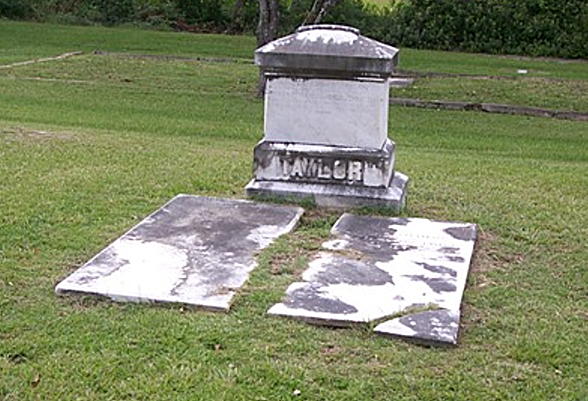
The Grave of Walter L. Taylor
Photo by Mike Dover from the Find A Grave website
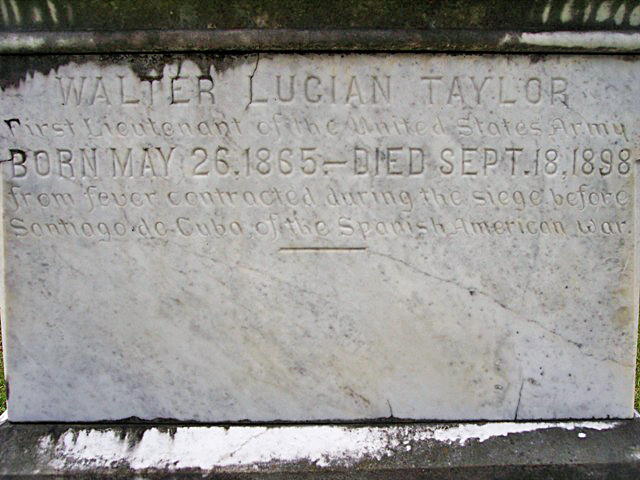
The inscription on the monument of Walter Taylor's grave. It reads:
WALTER LUCIAN TAYLOR
First Lieutenant of the United States Army
BORN MAY 26, 1865.---DIED SEPT. 18, 1898
from fever contracted during the siege before
Santiago de Cuba, of the Spanish American War
Photo by Mike Dover from the Find A Grave website
1 Department of Defense official figures
2 During the Santiago Campaign in Cuba, 1st Battalion consisted of Companies A, B, C and E. 2nd Battalion consisted of Companies D, F, G and H.
3 Annual Reports of the War Department for the Fiscal Year ending June 30, 1898 Washington, Government Printing Office 1898
4 Thirty-second Annual Reunion of the Association & Graduates of the United States Military Academy, at West Point, New York, June 8th, 1901 Saginaw, Mich. Seemann & Peters, Printers and Binders 1901
Additional material from:
Returns from Regular Army Infantry Regiments,
June 1821–December 1916. NARA microfilm
publication M665
National Archives and Records Administration, Washington, D.C.
Top photo from Thirty-second Annual Reunion of the Association & Graduates of the United States Military Academy, at West Point, New York, June 8th, 1901 Saginaw, Mich. Seemann & Peters, Printers and Binders 1901
Home | Photos | Battles & History | Current |
Rosters & Reports | Medal of Honor | Killed
in Action |
Personnel Locator | Commanders | Station
List | Campaigns |
Honors | Insignia & Memorabilia | 4-42
Artillery | Taps |
What's New | Editorial | Links |